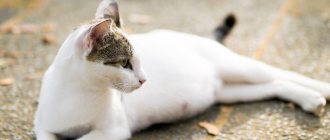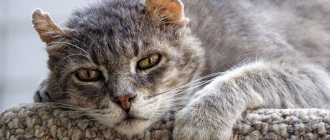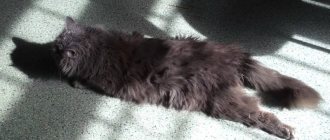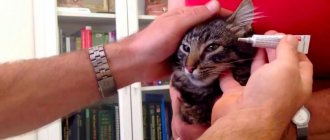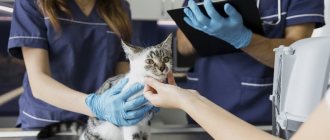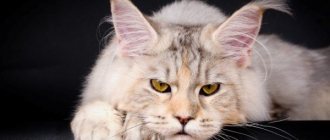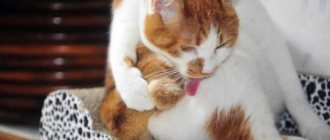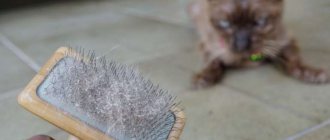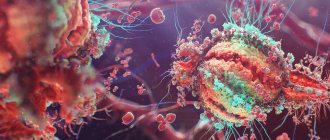What is microsporia in cats: information about pathology
Microsporia in cats is a separate fungal pathology, usually caused by a fungus of the species Microsporum Gypseum, sometimes by other representatives of the genus Microsporum. The problem is that in practice all pathologies caused by pathogens from the genus Trichophyton are also called the same.
In fact, they cause a separate disease called trichophytosis. To the eye (and in many other ways), the differences between these two diseases are so minimal that in practice, veterinarians usually call all these diseases dermatophytes, without making any special distinctions between them.
There is one more important nuance concerning the same Microsporum Gypseum. Scientists are still arguing about its exact species specificity, but there is little sense in this: it is known for sure that this parasitic fungus can affect not only cats, but also dogs, chinchillas, rabbits, other domestic and wild animals, as well as humans. The worse the potential host’s immunity, the greater the chance of infection.
Interesting! The feline variety of this disease is considered the most unpleasant. The reason is the increased virulence and infectiousness of the cat strain.
For example, the canine strain of the pathogen is not that dangerous for humans (albeit with reservations), although just one contact with a sick cat (which may well not have signs of the disease) results in infection with a probability of about 70%.
Causes and provoking factors
The disease is caused by the causative agent of lichen, which is transmitted from a sick animal to a healthy one through direct contact, as well as through common objects: blankets, toys, dishes. Only an animal with a weakened immune system can become infected; this condition is predisposed to:
- persistent infections;
- parasites;
- constant stress;
- poor nutrition;
- vitamin deficiencies;
- long-term use of medications.
In such conditions, the body's resistance to microbial agents that can cause infection decreases. The fungus quickly affects the layers of skin, hair and nails.
Basic differences between microsporia and trichophytosis
As we have already written, the differences between microsporia and trichophytosis are small, but they still exist:
- With microsporia, the parasite lives on the surface of the hair, while with trichophytosis it affects the hairs from the inside.
- Microsporia can usually be diagnosed using a Wood's lamp, while fungi of the genus Trichophyton usually do not reveal themselves under UV radiation.
- Unlike trichophytosis, microsporia is usually accompanied by quite severe itching.
It should be noted that the differences listed above are not very specific, and in practice the difference between diseases becomes even more blurred. The only 100% difference is the location of the pathogen (on the fur/inside the hair).
How does a fungal infection occur?
A prerequisite for the development of a fungal infection is the contact of fungal spores and hair cells. The spores then begin to germinate on the surface of the skin and penetrate the hair follicles. A fungal infection, destroying the surface of the hair, penetrates deeper. At the same time, the animal’s fur loses its shine, the hair becomes brittle and begins to break off. At the site where the fungus grows, the animal’s skin becomes inflamed and begins to itch. Elements of fungi enter the lymph and blood, spread throughout the body, causing the emergence of new foci of infection.
Symptoms, initial stage and first signs of microsporia in cats
Owners need to remember that the symptoms, initial stage and first signs directly depend on what particular form of microsporia their pet has developed.
But it is still possible to identify the main symptoms, which are typical for all forms of the disease:
- A sudden and inexplicable change in the condition of the cat's fur. With microsporia, it can become rarer, stiffer, brittle and unpleasant to the touch.
- You can see a grayish coating on your pet's fur. True, this only works in the case of light-colored cats, as well as completely black pets.
- The cat becomes restless and itches often.
- Bald patches on a cat's body. In mild cases or in the early stages, they usually appear on the face, ears, chin, as well as on the abdomen and genital area.
- The skin of a sick cat begins to peel off and even become scaly.
- There are no signs of severe inflammation in the bald areas, but they gradually grow. If you look closely, the skin in these places is literally strewn with “stumps” of hair broken off at the root.
- If left untreated, the cat becomes completely bald, covered with scales and scabs, and wounds and ulcers appear on its skin, which are quickly contaminated with pathogenic microflora. Not all cats survive to this state, since the animal usually dies much earlier from sepsis or secondary infections.
Surface form
The easiest and most common option. In this case, bald patches with hair stumps quickly appear on the cat’s skin. As a rule, the process develops quite quickly, within a maximum of three weeks.
Very often, the skin of a sick cat is infested with pathogenic microflora, which is why pyoderma and other variants of purulent inflammation of the skin are not uncommon.
Deep, follicular microsporia
The most severe version of the disease. Fortunately, it doesn't happen often. But if the symptoms described below appear, the owner needs to urgently take the cat to the nearest clinic:
- Bald patches quickly appear on the skin.
- On bald areas of the skin, ulcers, scabs, and deep wounds form in just as short a time. All these injuries do not heal, but quickly fester.
- Damage has an unpleasant tendency to merge and form peculiar conglomerates. The general condition of the cat quickly deteriorates, and the pet is at great risk of dying due to sepsis.
Hidden microsporia
In cats, this variant is found only slightly less frequently than the superficial form. Microsporia in this variant is extremely insidious, since for a long time the cat does not have any clear clinical signs, but at the same time it is already contagious both to other animals and to humans.
However, with luck and some attention, you can see signs that something is wrong:
- Grayish coating on the fur.
- The animal scratches itself frequently, even if it is wearing antiparasitic collars.
Clinical manifestations characteristic of microsporia can take a long time to develop, sometimes over several months. In addition, this variety often becomes chronic, characterized by periodic relapses.
Erased form
The rarest variety. In fact, in this case the disease is chronic, relapses manifest as the formation of small bald patches and crusts on the pet’s skin. As a rule, there are no other clinical signs.
Of course, in this case too, the pet is contagious to surrounding animals and people.
Signs characteristic of lichen
Typical symptoms of this disease are:
- round, hairless areas of skin;
- redness;
- peeling of the skin and crust;
- the appearance of dandruff, dulling of the coat;
- itching (not always evident).
Ringworm is usually found in a specific area of the skin, that is, it is a focal or symmetrical focal lesion; only in dogs there is a generalized form of the disease, which can cause extensive damage.
There are also less typical manifestations of dermatophytosis. So, in dogs, these are kerion (a clearly defined raised round nodular lesion, most often located in the muzzle or forelimbs) and so-called mycetomas - damage to the claws and fingers, chronic inflammation of soft tissues, caused by a fungus.
Dermatophytic mycetoma can also occur in cats . Persian cats are predisposed to this disease (in 99% of cases). The neck, back, tail, and sides of the pet are most often affected.
If you find similar symptoms in your pet, then do not put off visiting a doctor until later. Remember that there is a huge chance that you and your family members will become infected; you must follow the rules of personal hygiene and isolate the animal during treatment.
Tests and diagnostic methods
All tests and diagnostic methods are extremely important, as they quickly determine whether a cat has a fungal infection, which is also dangerous for humans. Today, veterinarians around the world use three main methods:
- Wood's lamp. This is a special lamp that uses a UV radiation source as a lamp. A sort of mini-solarium. The essence of his work is that under ultraviolet light, some strains of dermatophytes begin to fluoresce. Accordingly, in cases where a cat’s fur begins to glow, like a neon sign in a store, a positive diagnosis of microsporia can be confidently made.
- Microscopic examination of hair samples and skin scrapings from the boundaries of healthy and diseased tissue. The most common and “simple” method. The complexity of the study prevents us from calling it simple without quotation marks: only an experienced veterinarian will be able to detect the mycelium of parasitic fungi.
- Growing a pathogen culture on a nutrient medium. The most reliable, but complex and time-consuming method. Fungi need a specific and expensive environment, and they grow on it for a long time. Therefore, the technique, even if it produces a 100% result, is used, rather, not to make, but to confirm the diagnosis after the fact.
Where and how can you get ringworm?
Ringworm is a contagious skin disease that can be transmitted to humans. Infection occurs in the following ways:
- Through direct contact with an infected animal or asymptomatic carriers (mainly long-haired cats).
- Through contact with contaminated environments and care items (including combs, brushes, mats, transport baskets, etc.).
Note! Not every contact with an infected animal inevitably leads to the development of the disease. People with strong immunity have many specific and non-specific defense mechanisms of the body that prevent infection. Young children are most susceptible to the disease.
Among animals, there are also certain factors that contribute to the infection and development of fungal infections:
- Repeated contact with infected relatives. For example, if several animals live in the house.
- Age. Kittens under one year of age and cats over 10 years of age are less resistant to infection.
- Anything that weakens the immune system: other diseases, parasites, poor feeding, poor ventilation, little sun and fresh air, stress, etc.
Treatment of microsporia in cats
I would like to immediately note that the treatment of microsporia in cats is a rather lengthy process that requires patience and time. You should not count on a quick recovery for your pets.
Important! If the cat is not treated, the animal will either become a carrier, or the disease will become latent, chronic. It is even more difficult to cure, and all this time the pet will continue to remain infectious to other pets, as well as owners.
It is possible to stop treatment, considering the cat to have recovered, only after a thorough veterinary examination and at least two negative microscopic examinations of the skin and fur.
And further. The medications used in the treatment of severe and advanced forms of the disease are very “severe”; their long-term use is fraught with the development of problems with the kidneys and liver. Therefore, it is better not to let things get to this point, starting treatment for microsporia immediately after diagnosing the disease.
Approximate treatment plan
The treatment regimen below is just an approximate one, it needs to be modified for each specific case, taking into account the characteristics of a particular animal (consultation with a veterinarian is also required):
- First, the pet is prepared for treatment. To do this, you need to carefully trim the hair around the lesions. If the cat has long hair, it is generally advisable to trim it entirely. This measure will greatly facilitate mandatory medical procedures, including the application of ointments and other antifungal drugs.
- Apply antifungal ointments to both the affected areas and the skin around them. It is necessary to capture at least a centimeter of healthy tissue. This will prevent further spread of the pathogenic fungus. Ointments must be applied daily.
- Sick cats must be washed with shampoos with antifungal and keratolytic effects. This allows you not only to destroy the pathogen, but also to cleanse your pet’s skin of crusts, scabs and scabs. This is not done for the sake of improving the appearance of the pet (although for this purpose too): it is easier to apply medications to clean skin and they act much faster. As a rule, in the initial stages of treatment, washing should be done every three days, and subsequently the frequency of treatments can be reduced to twice a week.
- Antifungal agents are prescribed in the form of injections or tablets for oral use. The frequency of their use is determined by the veterinarian. You should not do this yourself, as you can easily poison your pet.
- If the case is severe and the pet will have to be treated for a long time, he must be prescribed multivitamins and immunostimulants. This will keep the cat healthy and speed up the normalization of its condition.
Medications
We list the main drugs used by veterinarians in the treatment of not only microsporia, but also trichophytosis and other dermatophytes:
- Ointment Yam. The drug is “simple”, it has a not very pleasant smell and an extremely sticky consistency, which is why letting a cat smeared with it on the sofa or bed is not the best idea. But the medicine is cheap and quite effective. For microsporia, use it at least three times a day, generously lubricating the lesions on the skin.
- Ivamerol. A product that has gained special recognition in recent years from many veterinarians and cat lovers. Before use, the drug solution is diluted in water (preferably boiled and settled) in a ratio of 20 ml of the composition per liter of water. The amount of mixture is calculated in such a way that it hides the cat seated in it up to the neck. Exposure duration is at least five minutes.
- Intraconazole-based products. Prescribed in a dose of 10 to 18 mg per kilogram of the cat’s live weight (at the discretion of the veterinarian). Since these medications negatively affect the liver of animals, hepatoprojectors (Essentiale-Forte and the like) are additionally prescribed.
Folk remedies
In general, we would not recommend using folk remedies for microsporia, especially in severe cases. They are not particularly effective, but they can easily trigger and complicate the disease. But still, for superficial microsporia, the following is sometimes used:
- A mixture of tar and laundry soap in a 1:1 ratio. First, the “raw materials” are grated on a fine grater and slightly heated in a water bath to obtain a semi-liquid slurry. It is applied to the lesions (but the composition should not be hot) three times a day. Exposure time - 15 or 20 minutes. If signs of irritation appear, the exposure period is reduced to 6-7 minutes.
- Birch tar, but in the case of cats its use is contraindicated. If there are no alternatives at all, a small amount of tar is applied to the affected areas of the skin for 15 minutes, and at this time a surgical collar is put on the animal or held so that the cat does not lick the smeared areas. Then the tar is thoroughly washed off with warm water and baby soap. If your pet gets tarred, it may die.
- Alcohol tincture of iodine. They lubricate the lesions twice a day.
Drug therapy for ringworm in cats
- Fungin (spray of the drug) is used externally The active ingredients are clotrimazole and propolis. During treatment, the owner uses a cotton swab to treat most of the affected skin, including the border areas of healthy skin (no more than 2 cm from the lesion). This drug is used for 2 weeks 1 time per day.
- Ointment Yam. Apply 2 times a day until the crusts begin to separate and new hair begins to grow. Due to the fact that this drug is potent, owners should not apply this ointment to the skin of the ears (it will cause burns).
- Sanoderm ointment - used 2 times a day. The course of treatment is 2-4 weeks.
Antifungal shampoos with chlorhexidine and miconazole are used as therapeutic bathing. (Doctor; Synergy LABS; Alezan). Cats suffering from ringworm are washed with shampoo once every 3 days for 6 weeks.
When treating ringworm, medications containing sulfur, creolin and tar are used (Zoomicol, creolin, birch tar, sulfur ointment, epilconazole).
Caring for a sick cat
Caring for a sick cat is no different, but... With microsporia, the main rule of care is to make sure that other pets and people themselves do not suffer. Therefore, the following rules must be observed:
- If the cat has long hair, then, as we have already said, it needs to be cut. All wool must be collected and burned to prevent the spread of infection.
- A sick pet needs to eat well and properly (to prevent “sagging” immunity), and therefore it is either transferred to high-quality “natural” food or holistic food.
- To prevent the spread of infection throughout the apartment, we highly recommend limiting the movements of a sick cat to one room. And, by the way, it is necessary to carry out wet cleaning every day, and ideally even carry out quartz treatment.
Vaccination and vaccines as a way to prevent and treat microsporia
Since the disease we are describing is quite dangerous (including for humans), scientists have long been researching the possibilities of preventing it. This is how vaccination and vaccines against microsporia appeared. They are unique in that you can vaccinate not only healthy cats, but also already sick cats (i.e., these vaccines can act as medicine).
Domestic experts recommend using the following varieties:
- Polivak-TM. Dose – 0.6 ml per administration. For prevention, vaccination is necessary; during treatment, it is repeated after two weeks.
- Vakderm. Dose: 0.5 ml per cat. Unlike the previous drug, revaccination is mandatory after two weeks (regardless of the purpose of using the vaccine).
Both products do not provide 100% protection for your pet from microsporia, but they significantly reduce the risk of developing severe forms of it and significantly speed up recovery.
Prevention of microsporia
All prevention of microsporia is as follows:
- If the area is unfavorable due to illness, you should not let the cat go outside again, thereby protecting it from contact with stray animals.
- For walks on the street, it is better to use a harness that will prevent the animal from running.
- Your pet should be vaccinated against microsporia at least once a quarter.
- Do not develop other diseases that lead to a severe weakening of the immune system.
Factors of occurrence
The occurrence and development of the pathological process can be influenced by several reasons:
- reduced activity of the pet's immune system;
- influence of stressful situations;
- inappropriate hygiene requirements in the premises;
- injury to the skin.
The disease can occur in cats at any age. The risk group includes newly born kittens and animals living on the street.
Disinfection of living quarters
In order not to become infected yourself and not to endanger your family, you must always remember: high-quality disinfection of a living space is the key to health.
You need to do the following:
- The room with a sick cat is wet cleaned daily. At the same time, “killer” amounts of chlorine bleach are added to the water. Since cats do not like chlorine, after this everything is washed off with clean water and the room is ventilated.
- The floors in the house are vacuumed regularly. After this, it is advisable to burn the dust collection bags, and wash the containers of vacuum cleaners with water cleaning with the same chlorine-containing products.
